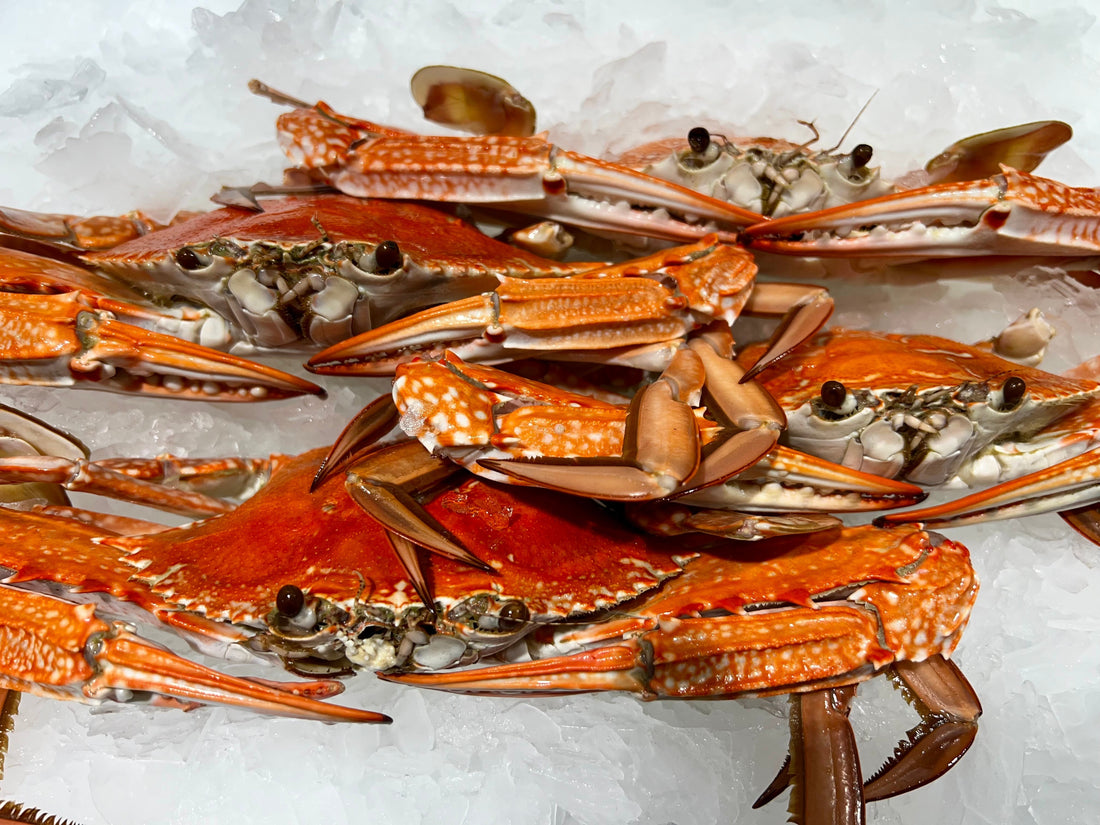Sand crabs reward careful timing and clean flavours. Keep them cold, cook them briefly, and season with a light hand. If you are planning a seafood night and checking sand crabs for sale, this step-by-step guide covers boiling, steaming, a quick chilli wok, and preparing crabs for a neat cold platter.
Preparation and humane handling
Buy live or freshly cooked crabs from a reputable retailer. If cooking live, chill them in a salted ice slurry for about 20 minutes until unresponsive. Set up a stable board and keep everything cold. Lift the abdominal flap, remove the top shell, pull out the gills and internal matter, and rinse lightly under cold water. Split the body into halves or quarters and crack the claws with the back of a knife so heat reaches the centre. Pat dry before cooking to avoid diluting your seasoning.
Good aromatics are simple: bay leaves, parsley stalks, lemon peel, peppercorns. They lift sweetness without masking it. Salt matters more than anything else, so measure it.
Boiling: fast and consistent
Boiling suits whole crabs or large halves and gives even results. Use a large pot and seawater-strength brine, roughly 30 g salt per litre. Bring to a rolling boil before the crabs go in. Lower them gently, return to a steady simmer, and start the clock once the water settles.
- Small to medium sand crabs, 350–500 g: 5 to 7 minutes
- Large sand crabs, 600–800 g: 7 to 9 minutes
Pull a leg segment to test. The meat turns opaque and just firms up when done. Overcooking forces moisture out and dulls the flavour, so stay on the lower end and let carryover heat finish the job. Move the crabs straight to an ice bath for 5 minutes, then drain well. Planning a mixed spread for guests who prefer fillets? Some shops will list orange roughy for sale on the same day; roast it gently and serve alongside your crab.
Steaming: pure flavour, tender texture
Steaming keeps sweetness concentrated because less water touches the meat. Line a steamer basket with herb stalks to lift the pieces. Keep the water at a lively simmer, not a roaring boil. Steam halves and claws until the flesh is opaque and the shell feels hot to the touch.
- Small to medium: 7 to 9 minutes
- Large: 9 to 11 minutes
Rest for two minutes before cracking. Steaming leaves the shell cleaner for presentation and keeps juices inside. Building a multi-course dinner? Markets often have monkfish for sale, which roasts well while the crabs steam.
Chilli sand crab: quick wok method
Speed and heat do the work. Set a wok over high heat. Sauté oil, garlic, ginger, and sliced long red chilli. Add a spoon of tomato paste for body, a pinch of brown sugar, and balance with fish sauce and rice vinegar. Toss in cleaned crab segments and cracked claws. Stir-fry for 2 to 3 minutes to coat, then add a ladle of hot stock. Cover and simmer for another 3 to 4 minutes until the meat turns opaque and pulls easily from the shell. Reduce the sauce to a light glaze that clings. Finish with spring onion and coriander. Serve with steamed rice or toasted rolls to soak up the juices.
Cold platters: clean, bright, and easy to eat
Cook by boiling or steaming, then chill to 0–5°C. Crack claws and score leg segments before service so guests can open pieces without a struggle. Keep lemon, aioli, and a simple vinaigrette on hand. Avoid heavy dressings that swamp the delicate flavour. If you are ordering in, look for retailers that detail handling and delivery windows when they list sand crabs for sale online. Pack the finished platter over fresh ice and keep it shaded. If the temperature rises above 5°C, follow the 2-hour and 4-hour limits.
Picking meat with less waste
Twist legs away from the body and push out the meat with a skewer from the thin end. For the body, press down to loosen the chambers, then tease out flakes with the tip of a spoon. Keep claw meat in a separate bowl for garnish. Sand crabs yield less per kilogram than mud crabs, so plan portions with that in mind. For salads and rolls, mix claw meat with a little lemon and chives and hold it cold until plating.
Timing and seasoning at a glance
| Method | Salt guide | Typical time | Finish |
|---|---|---|---|
| Boil | 30 g per litre | 5–9 minutes by size | Ice bath 5 minutes, drain |
| Steam | Lightly salted aromatics | 7–11 minutes by size | Rest 2 minutes, crack |
| Chilli wok | Season the sauce | 6–7 minutes once in wok | Reduce to a glaze |
Storage and serving windows
Keep cooked crab at 0–5°C and eat within two days. Store covered to prevent odours. For platters, set the tray over ice inside the fridge so the meat stays firm. If you need to transport, pre-chill the esky, use plenty of ice packs, and keep the crab above the meltwater line. Planning a larger seafood menu and searching orange roughy for sale near me for a simple baked fish course works well, as both dishes benefit from the same cold-chain habits.
Buying tips and related options
Choose bright shells, clean ocean aroma, and weight that feels solid for size. Ask for today’s arrival times and request extra ice if you have a long drive. If you prefer delivery, pick retailers that publish cold-chain details and realistic cut-offs. When rounding out the menu, many cooks also buy monkfish online because its firm texture suits roasting or skewers and pairs neatly with crab on a shared table.
Cook decisively, keep temperatures tight, and season with restraint. Sand crabs repay that care with sweet, delicate meat that needs very little to shine.

